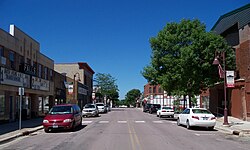Redwood Falls, Minnesota
| Redwood Falls, Minnesota | |
|---|---|
| City | |

Street in downtown Redwood Falls
|
|
 Location of Redwood Falls within Redwood County and state of Minnesota |
|
| Coordinates: 44°32′36″N 95°6′33″W / 44.54333°N 95.10917°W | |
| Country | United States |
| State | Minnesota |
| Counties | Redwood |
| Area | |
| • Total | 5.38 sq mi (13.93 km2) |
| • Land | 5.25 sq mi (13.60 km2) |
| • Water | 0.13 sq mi (0.34 km2) |
| Elevation | 1,040 ft (317 m) |
| Population (2010) | |
| • Total | 5,254 |
| • Estimate (2012) | 5,175 |
| • Density | 1,000.8/sq mi (386.4/km2) |
| Time zone | Central (CST) (UTC-6) |
| • Summer (DST) | CDT (UTC-5) |
| ZIP code | 56283 |
| Area code(s) | 507 |
| FIPS code | 27-53656 |
| GNIS feature ID | 0649900 |
| Website | www.ci.redwood-falls.mn.us |
Redwood Falls is a city in Redwood County, located along the Redwood River near its confluence with the Minnesota River, in the U.S. state of Minnesota. The population was 5,254 at the 2010 census. It is the county seat.
As the immigrant and Euro-American population of the North American east coast region grew, population pressures affected people far inland. People moved west to find new homes as more and more land was used by farmers. The Minnesota area is the ancestral homeland of the several Dakota peoples, who consisted of the loosely confederated Oceti sakowin (Seven Council Fires). By 1700, Ojibwe, who spoke an Anishinaabe language, had also come to what is now Minnesota from further east around the Great Lakes. At times they came into conflict with the Dakota over land and resources, and began to push them to the west.
The site of the future town of Redwood Falls was within the Dakota reservation area along the lower Minnesota River.
In 1864, Sam McPhail, a colonel who had commanded U.S. troops in the war and was a land speculator, claimed the land where Redwood Falls was developed. He hired men to use lumber from the Dakota reservation to build a fortified house and surrounded it with a sod stockade eight feet tall. McPhail published the Redwood Falls Patriot from 1866 to 1869. He was a probate judge and first Redwood County attorney. In 1872, he donated land for the county courthouse as Redwood Falls was designated as the county seat.
Among settlers who joined McPhail in 1864 was John St. George Honner. Honner claimed land north of Redwood Falls. The house he built in 1869 still stands in North Redwood and is listed on the National Register of Historic Places. Honner was appointed as the first postmaster and also served as a county official. Active in electoral politics, he served as a representative and later as a senator in the state legislature between 1866 and 1874. Honner operated a granite quarry near North Redwood and supplied the stone for the county courthouse.
...
Wikipedia
